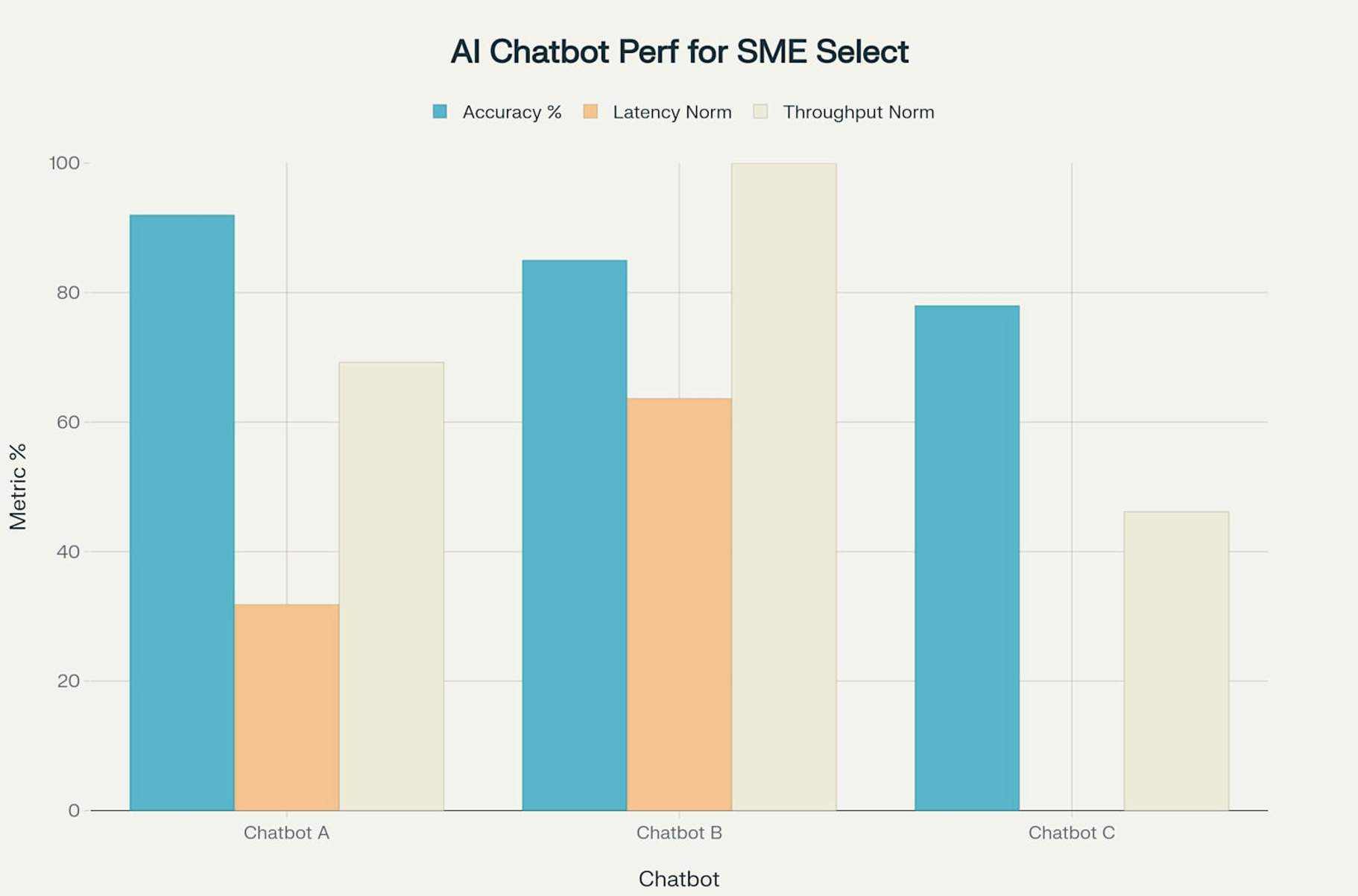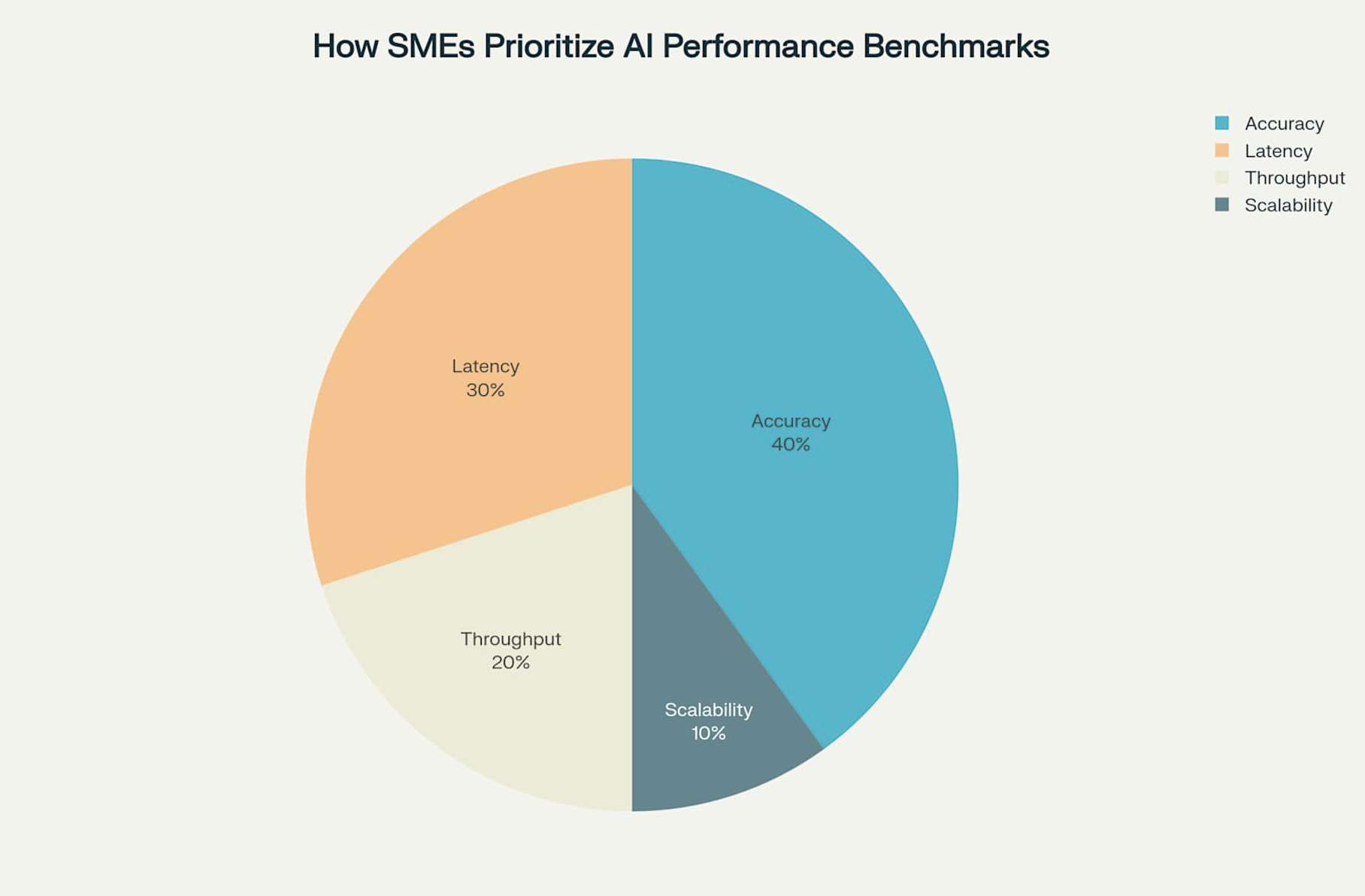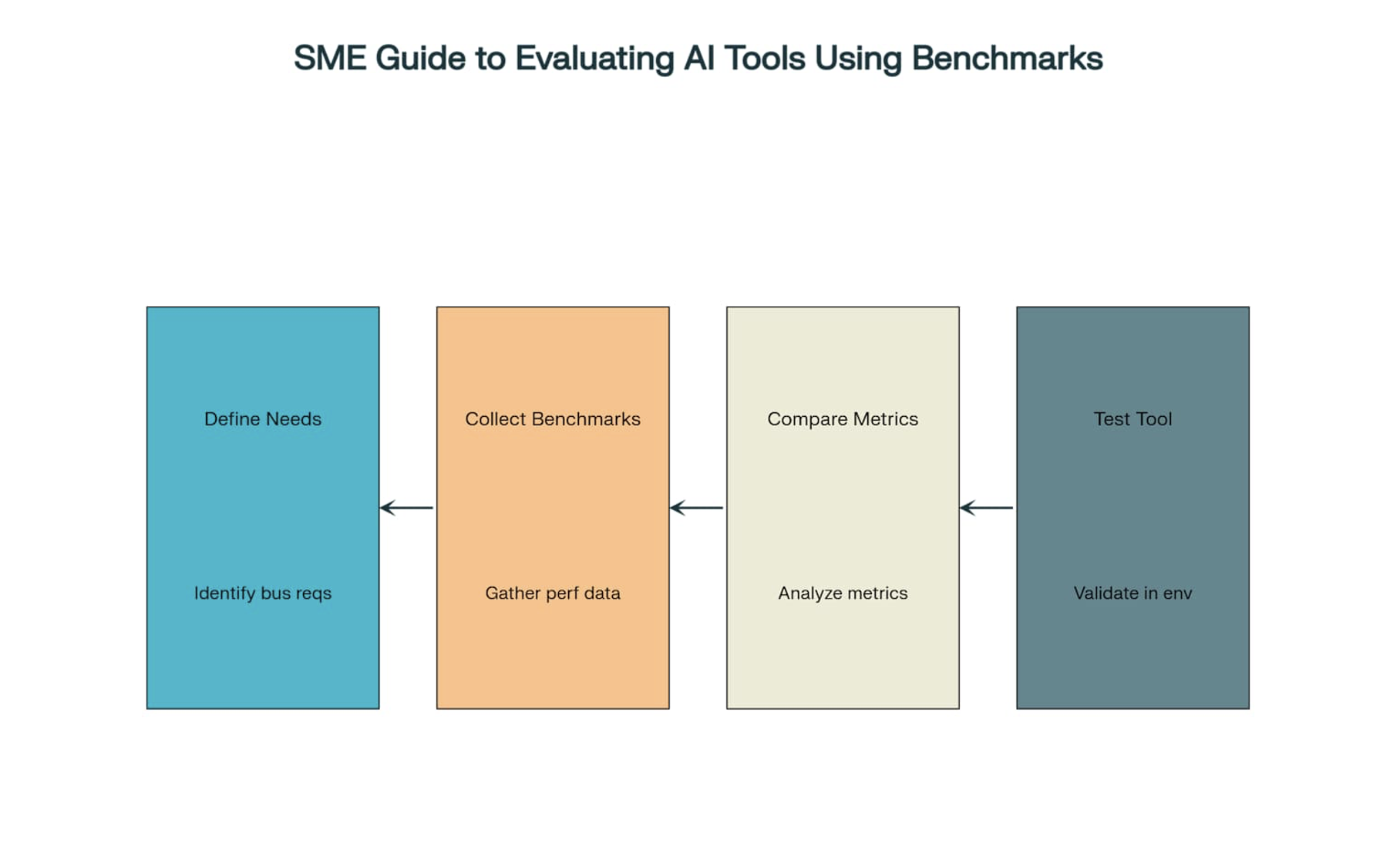Artificial intelligence is becoming essential for businesses of all sizes, including small and medium-sized enterprises. In 2025, AI adoption is rising fast, with 78% of organizations using AI in at least one business function, up from 55% just a year ago. For SMEs, adoption has reached 77% globally, proving AI is no longer exclusive to large corporations.
But with so many tools available, a major challenge emerges, how can SMEs evaluate and choose the right AI tools for their specific needs?
This is where understanding AI performance benchmarks becomes crucial.
This guide explains the most important AI performance benchmarks for SMEs, using simple language and real-world context. Key metrics like accuracy, latency, and throughput help small businesses make informed decisions when selecting tools for customer service automation, sales forecasting, and more.
Want to go deeper into specific metrics and tools?
Explore our supporting guides:
- Evaluating AI Models for SMEs Beyond Accuracy in 2025
- How AI Transforms Performance Management Systems for SMEs in 2025
- Key Metrics for AI-Driven Organizations: SME Focus in 2025
- Top Tools for AI Performance Evaluation in SaaS: A 2025 Guide
What are AI Performance Benchmarks?
AI performance benchmarks are standard metrics used to compare and assess different AI tools. These help businesses evaluate how well AI performs specific tasks, enabling more data-driven decisions.
For SMEs, benchmarks guide innovation and strategic planning.
In 2025, AI benchmarks include:
- Performance efficiency
- Scalability and adaptability
- Resource optimization
- Computational intelligence
- Ethical AI implementation
Core AI Performance Metrics to Understand
1. Accuracy
Accuracy shows how often an AI model gets predictions right. It is calculated as the number of correct predictions divided by the total predictions. While easy to understand, accuracy can be misleading when datasets are imbalanced. In those cases, precision and recall become equally important.
2. Latency
Latency measures how fast an AI system responds. It is critical for customer-facing tools like chatbots. Lower latency leads to better user experiences. This metric is also crucial in AI-powered performance systems that manage employee feedback and workflows.
3. Throughput
Throughput tracks how many requests an AI system can handle per second. High throughput is key for systems that support multiple users or large datasets. However, as throughput increases, latency may also increase, which creates trade-offs SMEs must consider.
4. Scalability
Scalability assesses whether an AI system can grow with your business. Benchmarks for scalability evaluate how well AI tools perform as data and users increase. Tools like MLflow and SageMaker are helping SaaS SMEs scale responsibly.
Why Benchmarks Are Essential for SME AI Adoption
For small and mid-sized businesses, investing in AI is a big decision. Without the luxury of large IT teams or massive budgets, every dollar spent needs to deliver real and measurable value. This is where AI performance benchmarks become essential. They help SMEs cut through the noise and make confident and informed choices when adopting new technology.
Making Smart Investments
Benchmarks help SMEs justify AI investments. With limited budgets, small businesses must ensure their tools deliver value. Benchmarks offer measurable performance insights that prevent costly trial-and-error.
McKinsey estimates AI could add $4.4 trillion in productivity. But SMEs must choose tools that match their business goals to unlock this potential.
Comparing AI Tools
AI vendors often claim their solutions are the best. Benchmarks allow SMEs to objectively compare options. For example, when evaluating chatbots, SMEs can weigh factors like accuracy, speed, and volume handling. Learn how multi-metric evaluation frameworks help move beyond surface-level metrics.

Chatbot B offers the best balance for SMEs. While Chatbot A has the highest accuracy, it falls short on speed and scalability. Chatbot C performs moderately but lacks throughput. Chatbot B combines solid accuracy, fast response time, and top throughput, making it the most efficient choice for growing businesses.
Ensuring Reliability and Long-Term Quality
Benchmarks help maintain quality. This is especially important in key functions like sales forecasting, workforce performance, and service automation where underperformance impacts revenue and satisfaction.
Monitoring AI Over Time
AI models evolve. Benchmarks provide a baseline to track changes and identify problems like model drift. Modern AI evaluation tools make it easier for SMEs to monitor this over time.
Key AI Metrics for SME Use Cases in 2025
SMEs rank accuracy as the top priority, followed by latency, throughput, and scalability when choosing AI tools.

For Customer Service Tools
- Self-service rate: Percent of issues resolved without human help
- First response time: How fast AI responds
- Average handle time: Total time to resolve each issue
- Customer effort score: Ease of issue resolution
- AI accuracy rate: Correctness of AI responses
- Customer satisfaction score: Overall experience with AI
Explore more service-focused metrics in our AI performance management guide.
For Sales Forecasting Systems
- Forecast accuracy: Match between predictions and actuals
- Market adaptability: Speed of response to changes
- Data processing: Capacity to analyze large and complex datasets
- Pipeline efficiency: AI's ability to detect sales risks and progression
For All AI Systems
- Computational efficiency
- Ethical AI
- Model health
- Generative AI quality
Case Study: Choosing the Right AI Chatbot
Amarra, a New Jersey–based distributor of special-occasion gowns, began using AI tools in 2020 to enhance operations like inventory management, product copywriting, and customer support.
Their Approach
- Deployed AI (ChatGPT) to generate product descriptions, cutting content time by 60%
- Used an AI-driven chatbot to handle around 70% of incoming customer inquiries
- Implemented an AI inventory system to reduce overstock by 40%
Outcomes
- Freed up staff to focus on complex support issues
- Maintained quicker response times and consistent customer communication
- Avoided overstock and optimized inventory levels
- Enhanced overall efficiency and customer satisfaction
This case study demonstrates how applying key AI metrics can lead to strong operational improvements.
Step-by-Step Framework for AI Evaluation

- Define goals
- Identify benchmarks
- Gather data
- Normalize and compare
- Understand trade-offs
- Test in real scenarios
- Monitor performance
Not sure which KPIs to prioritize? See our full guide on AI KPIs that matter most for SMEs.
Final Thoughts for SMEs Adopting AI in 2025
For small and mid-sized businesses, AI is no longer a futuristic idea—it’s a practical tool for solving real problems. But making the right choices starts with clarity, not complexity.
Benchmarks are more than technical metrics. They are your filter for cutting through vendor claims, your compass for aligning AI with business goals, and your safety net for ensuring long-term reliability.
Whether you're automating service, enhancing team performance, or scaling a SaaS platform, AI evaluation tools and performance benchmarks are your roadmap.
Ready to explore more about how AI can transform your business? Visit our reports page for in-depth insights on AI implementation.
FAQs
What is the difference between accuracy and precision?
Accuracy is overall correctness. Precision focuses on correct positive predictions. For fraud detection, high precision means flagged transactions are usually accurate. F1-score offers a better balance in such cases.
How do I pick the right benchmarks?
Benchmarks depend on your goal. For customer tools, accuracy and response time matter. For analytics, scalability and throughput are key.
Are there industry-specific benchmarks?
Yes. Retail may track recommendation accuracy; healthcare may focus on diagnostic precision. Our metrics guide offers industry-specific examples.
How often should I reassess AI tools?
At least quarterly. Review more frequently for critical systems or fast-moving environments.
Can benchmarks show ROI?
Yes. Benchmarks directly tie performance to cost savings and growth. Learn more in our article on AI ROI metrics for SMEs.



